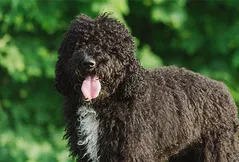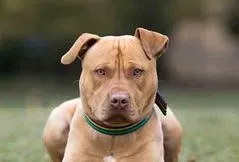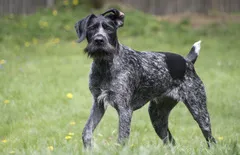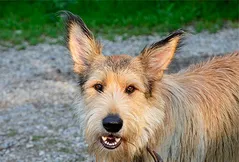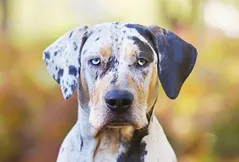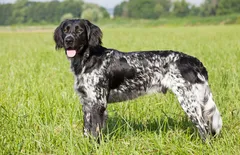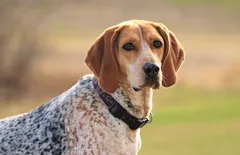
American English Coonhound
American English Coonhounds have long, low set, soft droopy ears, squared-off muzzles. They are kind, intelligent, sociable dogs.
Overall Status
| Height | 23 to 26 inches |
| Temperament | Sweet, Mellow, Sociable |
| Weight | 45 to 65 pounds |
| Life Expectancy | 11 to 12 years |
| Coat Color | Black, Blue, Brown, Red, White |
| Barking Level | Frequent |
Quick Factors
| Playfulness | |
| Dog Friendly | |
| Exercise Need | |
| Grooming Needs | |
| Strangers Friendly | |
| Family Affectionate |
Daily Care
Grooming Tips
The American English Coonhound certainly is not a breed that requires religious grooming or meticulous trimming. However, they do shed quite a bit throughout the year and should be brushed regularly to keep household hair build-up at bay. A thorough brushing once a week with a clean, firm-bristled brush should suffice. Coonhounds don’t need to be bathed very often.Usually, they only require a good shampooing after they have romped in mud puddles or otherwise had a particularly eventful frolic in the out-of-doors. Of course, a bath is an excellent idea after a Coonhound is sprayed by a skunk or rolls in any of the wild animal or livestock feces that they find so appealing.It’s a good idea to brush them before their bath, to minimize the mess caused by excess dirt and hair. Owners can discuss a dental care regimen with their veterinarian. They should clip their Coonhounds’ nails monthly, or as often as necessary to keep them fairly short and tidy.
Exercise Tips
The American English Coonhoundis an ideal candidate as a companion for someone who is an active runner, biker, or hiker. He needs a lot of exercises to stay healthy and happy.The breed has a very strong prey drive, so should never be allowed off leash in an uncontrolled situation, as he will not be able to resist the instinct to follow an interesting scent he detects with his sensitive nose. He requires a fenced area where he can run freely. Chasing a ball in his backyard can be an excellent source of exercise.
Feeding Tips
The American English Coonhoundshould do well on high-quality dog food, whether commercially manufactured or home-prepared with your veterinarian’s supervision and approval.Any diet should be appropriate to the dog’s age (puppy, adult, or senior). Remember that a working dog requires very different food than one who lives a more sedentary life. Coonhounds are prone to getting overweight as they age, so be mindful of your dog’s calorie consumption and weight level.Treatscan be an important aid in training, but giving too many can cause obesity. Learn about whichhuman foodsare safe for dogs, and which are not. Check with your vet if you have any concerns about your dog’s weight or diet.Clean, fresh water should be available at all times.
Health Tips
The American English Coonhound is a healthy breed, with an average lifespan of 11 to 12 years. Like other mid-to-large dogs, one of the most common health concerns is hip dysplasia. Other breed health predispositions may include ear infections (bacterial; yeast), progressive retinal atrophy (PRA).
Trainability
Following through with proper early socialization of your American English Coonhound is paramount, or your puppy may become possessive over food or toys in your home. The key to a well-adjusted, mentally healthy dog is to have him experience positive interactions with many different kinds of people in a variety of places and situations.Like many hounds, English dogs have a split personality: tenacious, tireless, and stubborn on the trail, but at home these spirited hunters are sweetly amiable companions. Still, the breed’s limitless prey drive and energy, the patience it takes to train them for anything other than coon hunting, and their tendency to bark in a loud, ringing voice make them most appropriate for experienced dog owners.
History
The American English Coonhound’s history is not terribly different from that of other treeing Coonhounds, which all descend from English Foxhounds. Coonhounds date back to the 1600s when English settlers brought Foxhounds to the North American colonies. Englishman Robert Brooke brought his pack of hunting hounds to America in 1650. In 1742, Thomas Walker imported a number of hound dogs from England to Virginia. George Washington, who was an avid fox hunter, had English hounds imported to this country in 1770. The early English Foxhound imports became known as “Virginia Hounds.” They are the predecessors of today’s American English Coonhound.Backwoods breeders crossed foxhounds with other breeds to create the American English, once known as the English Fox and Coonhound, as it could hunt foxes by day and raccoons by night. As the breed came to specialize on nocturnal raccoon hunts, it acquired its current name. (The breed was also known for a time as the Redtick Coonhound and, simply, the English Coonhound.) Since Colonial times, American English has been immensely popular among the tight fraternity of coon hunters. Today’s American English is considered by some experts as the fastest of the coonhound breeds.

